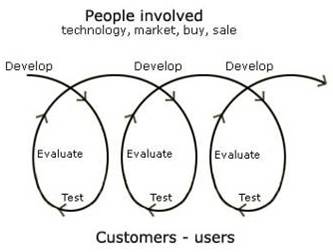Stage 3: Development

Product development begins! Develop and test the product, establish detailed marketing and operations plans. Prepare an updated financial analysis and resolve questions about legal issues (patents, copyright etc.).
When product development begins, there are two problems that you as a product developer will nearly always have to contend with:
- the product description is not correct (or not specific enough and thus unclear)
- things (internally and/or externally) have changed.
Stage 3 involves the development of the product and (concurrently) of detailed test, marketing, and operations plans. An updated financial analysis is prepared, and legal/patent/copyright issues are resolved.
Definition: Product development
Sources of problems you may experience during development:
- lack of commitment (money, time, personnel, senior management support)
- poor management (lack of strategic planning, lack of coordination, no assisted responsibility, bureaucracy, inexperience)
- poor organizational structure
- lack of motivation among human resources allocated to the projects; there are often no defined monetary and non-monetary rewards.
Working towards the final product
The biggest challenge is to ensure that the product you develop actually meets the needs and expectations of your customers.
In order to succeed in this you will need to be in constant contact with your customers in order to gain information about what you should do next.
Evaluate the project with your potential customers several times. They will help to drive development and give you valuable feedback for the next refinement of the product.
Challenge number two, the constantly changing world, means that you have to go through this stage as fast as possible. By doing so you minimize the danger of developing a product that was modern and in demand when you started the project but by the time of the launch is hopelessly inappropriate.
Develop-Test-Evaluate with the customer
Food science, and in particular sensory food science, plays a major role in product development. It is the R&D perspective in the NPD of foods. Depending on the professional setting, food science often rivals marketing as the pivotal discipline for a product's success. Since both areas can and should have a significant effect on product development, for a successful NPD project it is advisable to consider both areas as complementary and closely interdependent. The challenge is, however, to effectively combine both 'worlds' into one interface for decision making.
Sensory evaluation is defined as a scientific method used to evoke, measure, analyse, and interpret those responses to products perceived through the senses of sight, smell, touch, taste, and hearing (Lawless & Heymann, 1999).
A product sample or a prototype is developed in order to test certain properties, such as taste, tenderness, colour, form, smell etc.
Typically, the next activities to be carried out are further laboratory tests with experts as well as consumers. Experts are often employed to specify degrees of intensity of sensory attributes in order to achieve the best combination. Consumers are surveyed for hedonic product testing to assess liking (satisfaction) and preference (better or worse than a competing product).
The information that is sought and obtained in these activities must be stored and collected. Only then will it be possible to take the project in the right direction. The same thing is repeated in a sequential process with increasingly more information available about the product and prototype. You are getting closer to the final version ...

Figure 8. Iterative process.
Note: Things change because the world does not stand still! Bear in mind that projects that are running now were initiated at times when the company situation and the market environment may have been very different from the present day. An inaccurate product description may therefore be a result of:
- assumptions made at the concept stage that now appear not to be sustainable
- necessary resources and competences being unavailable, or
- customers who were positive at the concept stage now becoming more negative.
Cutting development time
Speed means a lot, but don't rush through a project! Don't let the product develop quickly at the expense of quality. In order to work quickly and effectively in developing a product, the most important thing is preparation. The time factor should not be allowed to take precedence over the quality of a company's work.
In order for your company to become skilled at developing new products, both theoretical competence and practical experience are necessary.
- Speed yields competitive advantage: beating competitors to market.
- Speed yields higher profitability: revenues are realized earlier and more revenues are realized.
- Speed means fewer surprises and reduces the odds.
But do not speed up at the expense of quality of execution!
Barriers to rapid product innovation:
- lack of clarity about goals and strategic direction
- insufficient top management support
- excessive bureaucracy, rules, procedures
- employee turnover: key skills leaving the firm.
Here are some ways to increase speed of development:
- Build in quality of execution at every stage: the best way to save time is by doing it right the first time.
- Do the homework in advance and be ready; agree on an early product definition: this saves time downstream.
- Organize around multi-functional teams with empowerment: 75% of time slippage is due to sending memos up and down the organization and sequential (or delayed) problem solving.
- Do things concurrently and across functions.
- Prioritize and focus (do not dissipate resources across projects).
- Design for speed (CAD and prototyping, use of common components, make the product easy to test, design for fast trial, use standardized process plans).
- Prepare for rapid marketing (use roll-outs, not test marketing, speed up publicity, get immediate market awareness, try to secure trial purchasing, set up customer service ahead of rollout).
Some notes on the way about product development and quality
Please bear following in mind:
- Get it right first time. Ensure quality in the implementation of each phase in the production of a new product.
- Do your homework. Developing new products may involve more work than you think.
- Run parallel activities. Get the various project participants working simultaneously and involve your consultants early in the project, for example the packaging designers, publicity people, etc.
- Don't stop! Don't hold up the project because information or resources are lacking. If you have started on a good basis and done your homework you will be able to make the decision to call off or continue with the project.